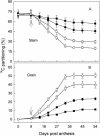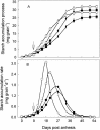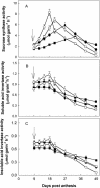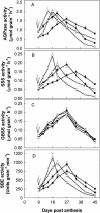Activities of key enzymes in sucrose-to-starch conversion in wheat grains subjected to water deficit during grain filling
- PMID: 15235118
- PMCID: PMC519076
- DOI: 10.1104/pp.104.041038
Activities of key enzymes in sucrose-to-starch conversion in wheat grains subjected to water deficit during grain filling
Abstract
This study tested the hypothesis that a controlled water deficit during grain filling of wheat (Triticum aestivum) could accelerate grain-filling rate through regulating the key enzymes involved in Suc-to-starch pathway in the grains. Two high lodging-resistant wheat cultivars were field grown. Well-watered and water-deficit (WD) treatments were imposed from 9 DPA until maturity. The WD promoted the reallocation of prefixed 14C from the stems to grains, shortened the grain-filling period, and increased grain-filling rate or starch accumulation rate (SAR) in the grains. Activities of Suc synthase (SuSase), soluble starch synthase (SSS), and starch branching enzyme (SBE) in the grains were substantially enhanced by WD and positively correlated with the SAR. ADP Glc pyrophosphorylase activity was also enhanced in WD grains initially and correlated with SAR with a smaller coefficient. Activities of granule-bound starch synthase and soluble and insoluble acid invertase in the grains were less affected by WD. Abscisic acid (ABA) content in the grains was remarkably enhanced by WD and very significantly correlated with activities of SuSase, SSS, and SBE. Application of ABA on well-watered plants showed similar results as those by WD. Spraying with fluridone, an ABA synthesis inhibitor, had the opposite effect. The results suggest that increased grain-filling rate is mainly attributed to the enhanced sink activity by regulating key enzymes involved in Suc-to-starch conversion, especially SuSase, SSS, and SBE, in wheat grains when subjected to a mild water deficit during grain filling, and ABA plays a vital role in the regulation of this process.
Figures






Similar articles
-
Post-anthesis alternate wetting and moderate soil drying enhances activities of key enzymes in sucrose-to-starch conversion in inferior spikelets of rice.J Exp Bot. 2012 Jan;63(1):215-27. doi: 10.1093/jxb/err263. Epub 2011 Sep 16. J Exp Bot. 2012. PMID: 21926094
-
Activities of fructan- and sucrose-metabolizing enzymes in wheat stems subjected to water stress during grain filling.Planta. 2004 Dec;220(2):331-43. doi: 10.1007/s00425-004-1338-y. Epub 2004 Jul 29. Planta. 2004. PMID: 15290295
-
Activities of starch hydrolytic enzymes and sucrose-phosphate synthase in the stems of rice subjected to water stress during grain filling.J Exp Bot. 2001 Nov;52(364):2169-79. doi: 10.1093/jexbot/52.364.2169. J Exp Bot. 2001. PMID: 11604456
-
Improving starch yield in cereals by over-expression of ADPglucose pyrophosphorylase: expectations and unanticipated outcomes.Plant Sci. 2013 Oct;211:52-60. doi: 10.1016/j.plantsci.2013.06.009. Epub 2013 Jul 12. Plant Sci. 2013. PMID: 23987811 Review.
-
Grain filling of cereals under soil drying.New Phytol. 2006;169(2):223-36. doi: 10.1111/j.1469-8137.2005.01597.x. New Phytol. 2006. PMID: 16411926 Review.
Cited by
-
Chlorocholine chloride and paclobutrazol treatments promote carbohydrate accumulation in bulbs of Lilium Oriental hybrids 'Sorbonne'.J Zhejiang Univ Sci B. 2012 Feb;13(2):136-44. doi: 10.1631/jzus.B1000425. J Zhejiang Univ Sci B. 2012. PMID: 22302427 Free PMC article.
-
Drought Stress Tolerance in Wheat and Barley: Advances in Physiology, Breeding and Genetics Research.Int J Mol Sci. 2019 Jun 27;20(13):3137. doi: 10.3390/ijms20133137. Int J Mol Sci. 2019. PMID: 31252573 Free PMC article. Review.
-
Understanding Wheat Starch Metabolism in Properties, Environmental Stress Condition, and Molecular Approaches for Value-Added Utilization.Plants (Basel). 2021 Oct 25;10(11):2282. doi: 10.3390/plants10112282. Plants (Basel). 2021. PMID: 34834645 Free PMC article. Review.
-
Starch accumulation, activities of key enzyme and gene expression in starch synthesis of wheat endosperm with different starch contents.J Food Sci Technol. 2014 Mar;51(3):419-29. doi: 10.1007/s13197-011-0520-z. Epub 2011 Sep 28. J Food Sci Technol. 2014. PMID: 24587516 Free PMC article.
-
The relationship between characteristics of root morphology and grain filling in wheat under drought stress.PeerJ. 2021 Aug 19;9:e12015. doi: 10.7717/peerj.12015. eCollection 2021. PeerJ. 2021. PMID: 34466293 Free PMC article.
References
-
- Aggarwal PK, Sinha SK (1984) Effect of water stress on grain growth and assimilate partitioning in two cultivars of wheat contrasting in their yield in a drought environment. Ann Bot (Lond) 53: 329–340
-
- Ahmadi A, Baker DA (2001) The effect of water stress on the activities of key regulatory enzymes of the sucrose to starch pathway in wheat. Plant Growth Regul 35: 81–91
-
- Bollmark M, Kubat B, Eliasson L (1988) Variations in endogenous cytokinin content during adventitious root formation in pea cuttings. J Plant Physiol 132: 262–265
-
- Bradford MM (1976) A rapid and sensitive method for the quantitation of microgram quantities of protein utilizing the principle of protein-dye binding. Anal Biochem 72: 248–254 - PubMed
-
- Caley CY, Duffus CM, Jeffcoat B (1990) Effects of elevated temperature in developing wheat grains. Aust J Plant Physiol 17: 431–439
Publication types
MeSH terms
Substances
LinkOut - more resources
Full Text Sources
Miscellaneous

